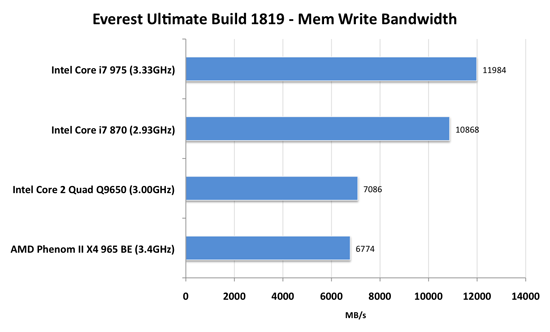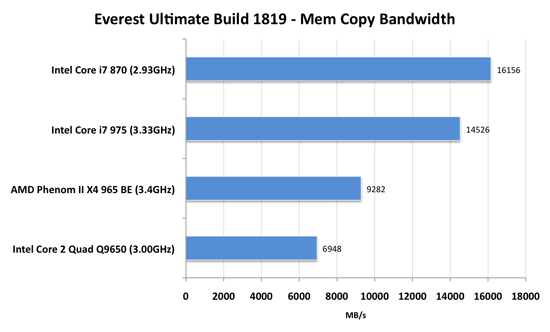Intel's Core i7 870 & i5 750, Lynnfield: Harder, Better, Faster Stronger
by Anand Lal Shimpi on September 8, 2009 12:00 AM EST- Posted in
- CPUs
Discovery: Two Channels Aren't Worse Than Three
Intel told me something interesting when I was out in LA earlier this summer: it takes at least 3 cores to fully saturate Lynnfield's dual-channel DDR3-1333 memory bus. That's three cores all working on memory bandwidth intensive threads at the same time. That's a pretty stiff requirement. In the vast, vast majority of situations Lynnfield's dual channel DDR3 memory controller won't hurt it.
Move up to 6 or 8 core designs and a third memory channel is necessary, and that's why we'll see those processors debut exclusively on LGA-1366 platforms. In fact, X58 motherboards will only need a BIOS update to work with the 6-core 32nm Gulftown processor next year. P55 looks like it'll be limited to four cores and below.
Because of this, Lynnfield's memory bandwidth and latency cores are actually quite similar to Bloomfield. I used Everest to look at memory bandwidth and latency between a Core i7 975 and Core i7 870 (Lynnfield):

Lynnfield's memory controller is good, easily as good as what's in Bloomfield if not slightly better.



Both processors turbo'd up to 3.46GHz, indicating that Everest's memory test uses no more than two threads. The 975 ran DDR3-1066 memory (the highest it officially supports), while the 870 used DDR3-1333. The faster memory gave the 870 the advantage. Since we're not taxing all four cores, Lynnfield is at no disadvantage from a bandwidth perspective. Surprisingly enough, even SiSoft Sandra (which does use four cores for its memory bandwidth test) shows Lynnfield's dual-channel DDR3-1333 memory controller as equal to Bloomfield's triple-channel DDR3-1066 interface.
| SiSoft Sandra 2009.SP4 | Intel Core i7 975 | Intel Core i7 870 |
| Aggregate Memory Bandwidth | 17.8 GB/s | 17.3 GB/s |
Long story short? Lynnfield won't be memory bandwidth limited with DDR3-1333 for the overwhelming majority of usage cases.










343 Comments
View All Comments
snakeoil - Tuesday, September 8, 2009 - link
and the cherry on top of the piecore i5 750 and core i3 don't support virtualization.
http://www.virtualization.info/2009/07/intel-core-...">http://www.virtualization.info/2009/07/intel-core-......
that's fantastic, colossal intel.
what's wrong with intel
Anand Lal Shimpi - Tuesday, September 8, 2009 - link
Intel VT-x is supported by the Core i5 750:http://processorfinder.intel.com/details.aspx?sSpe...">http://processorfinder.intel.com/details.aspx?sSpe...
Take care,
Anand
snakeoil - Tuesday, September 8, 2009 - link
sorry incomplete linkhttp://www.virtualization.info/2009/07/intel-core-...">http://www.virtualization.info/2009/07/...core-i3-...
AssBall - Tuesday, September 8, 2009 - link
What are you talking about? These overclock FINE; read the article. 4 Ghz. Anyone that is gonna overclock bloomfield or lynnfield seriously is opting for an aftermarket HSF, so don't bother arguing that. Your comment doesn't make any sense.TA152H - Tuesday, September 8, 2009 - link
You missed the point.When you overclock the processors, you change the characteristics of turbo mode. Consequently, the big advantage of the Lynnfield disappears, and they run at the same clock speed, instead of the Lynnfield at a higher clock speed.
Do you understand now?
eternalfantasy - Tuesday, September 8, 2009 - link
lolemogoinginstyle - Tuesday, September 8, 2009 - link
"There are better sites that have answered these questions. I used to like this site, but this review is another disappointment. "Just how is that Tom's Hardware gig working out for you? I noticed your name was not on any of their launch reviews since you seem to be an expert on the subject. Why is that?
TA152H - Tuesday, September 8, 2009 - link
Thanks for asking.When I have time, I will be writing another article, which they hopefully will use, but to be honest, the time it takes to write an article, at least a well-written one, takes an enormous amount of time and effort.
Getting and verifying data is only part of it. Writing it in an artistic an interesting way is very time consuming, and, at least for me, requires many rewrites of the same pages. Each page took me at least five hours, some many more, plus the upfront time of deciding which pages to write, which probably took at least 30 hours of research.
The editor of Tom's wrote their articles, and it's clear to see the much more thorough review he did. Personally, I like him and occasionally do communicate with him, and I probably would like Anand too, since he seems like a good fellow, but I have no real affiliation with their site. If I write an article they like, they might publish it. That's it.
But, honestly, if you do it for money, you're a fool. It takes WAY too much time for that. You really have to want to do it, and the money is secondary.
goinginstyle - Tuesday, September 8, 2009 - link
So it took you five hours a page to do a copy and paste from Wikipedia on that so called article of yours? I read the Tom's P55 article, not seeing how it was any more thoughtful than the one here or at Tech Report. At least Anand did some searching and reported on items like PCIe clocking/voltage requirements that I noticed was not mentioned at Toms.Your only motive for these posts is to try and look impressive at Toms in hopes that they will publish another boring piece of dung from you. Otherwise, your complaints here are just as justified at Toms or TR, yet you are not posting at either site. That is why it is so obvious as to what you are up to with the flame bait comments.
TA152H - Tuesday, September 8, 2009 - link
I never even looked at Wikipedia, since I don't consider it a valid source of information.Why do you talk about things you don't know about. In fact, some people used Wikipedia to argue some points with me. I made a point never to look at those pages.
But again, what have you done with your, except produce carbon dioxide and speed up global warming? You seem pretty worthless to me.